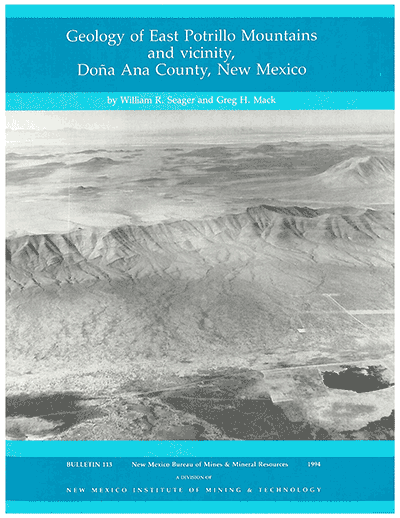
Bulletin 113—Geology of east Potrillo Mountains and vicinity, Doña Ana County, New Mexico
By W. R. Seager and G. H. Mack, 1994, 27 pp., 1 table, 16 figs,. 3 sheets, scale 1:24,000.

This is a companion to Geologic Maps 53, 57, 60, and 63.
The East Potrillo Mountains area is located in southwestern Doña Ana County,
approximately 25 mi west of El Paso and 34 mi southwest of Las Cruces. The
Mexico-United States border forms the southern limit of the map, and the
107º06'30" meridian delineates the western edge of the map; altogether approximately
90 mi2 of varied terrain were studied. The prominent volcanic domes of Mt.
Riley and Mt. Cox dominate the view, towering 1,475 ft or so above their
surroundings. To the southeast, the narrow ridge known as the East Potrillo
Mountains rises approximately 900-1,000 ft above the Bolson floor. Approximately
4,265 ft of sedimentary and volcanic rocks and alluvium, which range in
age from Middle Permian to Holocene, are exposed in the study area.
Situated just north of the Mexico border in south-central
Doña Ana County, New Mexico, the East Potrillo Mountains area reveals important
details about Laramide, middle Tertiary, and late Tertiary deformation in
the region, as well as data on Permian, Lower Cretaceous, and Cenozoic stratigraphy.
The oldest rocks exposed in the area are limestone, dolomitic limestone,
and minor silty or sandy beds, at least 300 m thick, that are believed to
be correlative with the middle Permian Yeso and San Andres Formations of
south-central New Mexico. Disconformably above these, Lower Cretaceous shelf
limestone, siltstone, sandstone, and conglomerate are approximately 570
m thick in the northern part of the range, thinning southward. These rocks
are Aptian-Albian in age and correlative with the Hell-to-Finish and U-Bar
Formations of southwestern New Mexico. Orthoquartzite, possibly correlative
with the Sarten or Mojado Formations, crops out locally. Cenozoic rocks
are poorly exposed around the margins of the East Potrillo Mountains and
on the flanks of the Mt. Riley-Mt. Cox volcanic domes. They include Upper
Cretaceous and/or lower Tertiary conglomerate and sandstone, middle Tertiary
intermediate-composition lavas and domes, and upper Oligocene or lower to
middle Miocene fanglomerate. The latter rocks are thought to have been deposited
in a broad "early-rift" basin extending 25 km or more to the west of the
East Potrillo Mountains. Quaternary alluvial fans, basin-floor deposits,
maar-rim tuffs, basalt flows, and cinder cones mantle older bedrock across
much of the map area. Altogether, approximately 1,350 m of Permian, Lower
Cretaceous, and Cenozoic rocks are exposed.
$10.00
Buy
Now
Also available as a free download.
Download
| File Name | Size | Last Modified |
|---|---|---|
| B113.pdf | 12.15 MB | 01/15/2021 11:03:37 AM |
| GeoPDF: | ||
| Bulletin113GeoPDF.pdf | 2.08 MB | 09/21/2021 07:42:59 AM |
| GISdata: | ||
| Bulletin113.mpk | 46.68 MB | 10/08/2020 02:04:19 PM |



